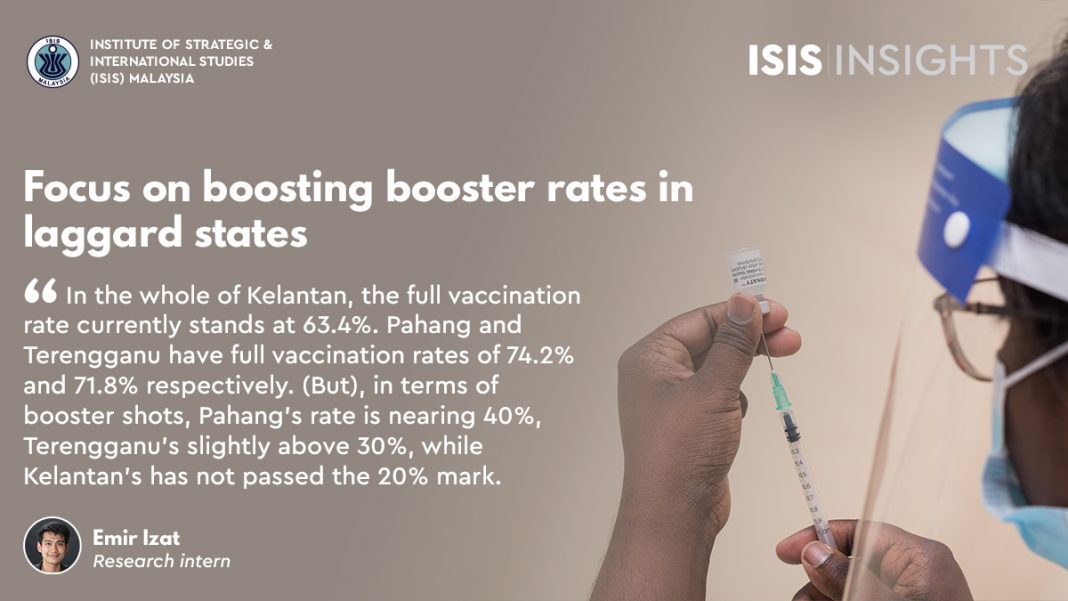Govt must deliver vaccines, make them accessible to the vulnerable who need third jab
by Emir Izat
ACROSS the nation, Covid-19 booster shots – or the third jab – are plateauing across many districts and vaccine inequalities are emerging once again
On 13 November 2020, the Orang Asli in Lojing district, Kelantan, barred visitors to their community as a public-health measure against the spread of Covid-19. Today, virtually everyone in the district is vaccinated fully, which speaks volumes about the government’s efforts in making vaccines accessible.
South of Lojing’s border is Cameron Highlands, a popular tourist destination. The full vaccination rate in Cameron Highlands is like Lojing but the similarity ends for the neighbouring districts when it comes to booster shots. In the whole of June, only 34 people in Lojing received booster jabs, which is less than 1% of the total population, while 75% of the Cameron Highlands population have had three doses. Despite Lojing’s stellar record in implementing public health measures, it faltered at boosters.
This is a trend across many districts. In the whole of Kelantan, for example, the full vaccination rate currently stands at 63.4%. Pahang and Terengganu have full vaccination rates of 74.2% and 71.8% respectively. In terms of booster shots, Pahang’s rate is nearing 40%, Terengganu’s slightly above 30%, while Kelantan’s has not passed the 20% mark. Although full vaccinations in the east coast states show differences, especially Kelantan, the booster rates are starker.
The slow booster uptake is also prevalent in Penang and Kedah, where both achieved the 70% herd immunity threshold for full vaccinations. However, Penang records a 62% booster uptake (one of the highest rates in the country), whereas Kedah’s half of Penang. In Sabah and Sarawak, the booster disparity between the two states is striking.
If we go down to district-level data, a troubling trend emerges. In most states, boosters are agglomerated in urban centres and major cities. In Pahang, for example, booster jabs are more prevalent in Kuantan, Cameron Highlands and Genting Highlands. Across the country, urban centres lead booster vaccinations – districts adjacent to them generally benefited as well. But boosters tend to drop as we move away from the cities.
Booster shots are important because of the waning immunity of the two initial vaccinations. Despite the decreasing efficacy in curbing infections of the new BA.5 Omicron subvariant, booster shots help to reduce hospitalisation and risk of deaths. Booster shots are especially important for those with comorbidities and existing health conditions.
In the face of new Covid waves, second boosters are necessary for high-risk individuals. However, even those with comorbidities are not taking up single booster shots in the same numbers as the initial two doses nationally. The problem is worse in rural areas. For example, in Kota Kinabalu, there are 20% fewer people with comorbidities taking up booster shots than the initial two-dose vaccinations. In Semporna, the rate is 75% less. We must prioritise booster shots for those with comorbidities in low-vaccination areas – which tend to be more rural, poorer and have less resources to deal with a major outbreak.
On 28 May 2022, Health Minister Khairy Jamaluddin urged the use of behavioural science in policymaking: imploring government bodies to develop incentive structures that encourage the population to make healthy life decisions.
In urban districts where vaccines are readily available, that call is justified. Falling booster rates are happening in rural and urban districts but rural districts generally face worse outcomes than urban ones. Changing behaviour through incentives is a great idea but the most effective nudge starts with having access to boosters and information. Due to the voluntary nature of booster shots, one must ask if it is vaccine hesitancy or inaccessibility that is behind the low booster rates.
Whatever the reason, data won’t tell us if individual decisions are to blame for not vaccinating. Data cannot explain the motivations or attitude of individuals: they only point to where we need to target for vaccine deployment to prevent deaths and hospitalisations. The data show a clear urban-rural divide. The government should pay attention to those who are the most vulnerable, those with comorbidities and health conditions who have yet to receive the extra jab. It needs to start delivering vaccines equitably.
The writer is an intern at the Institute of Strategic & International Studies (ISIS) Malaysia.





